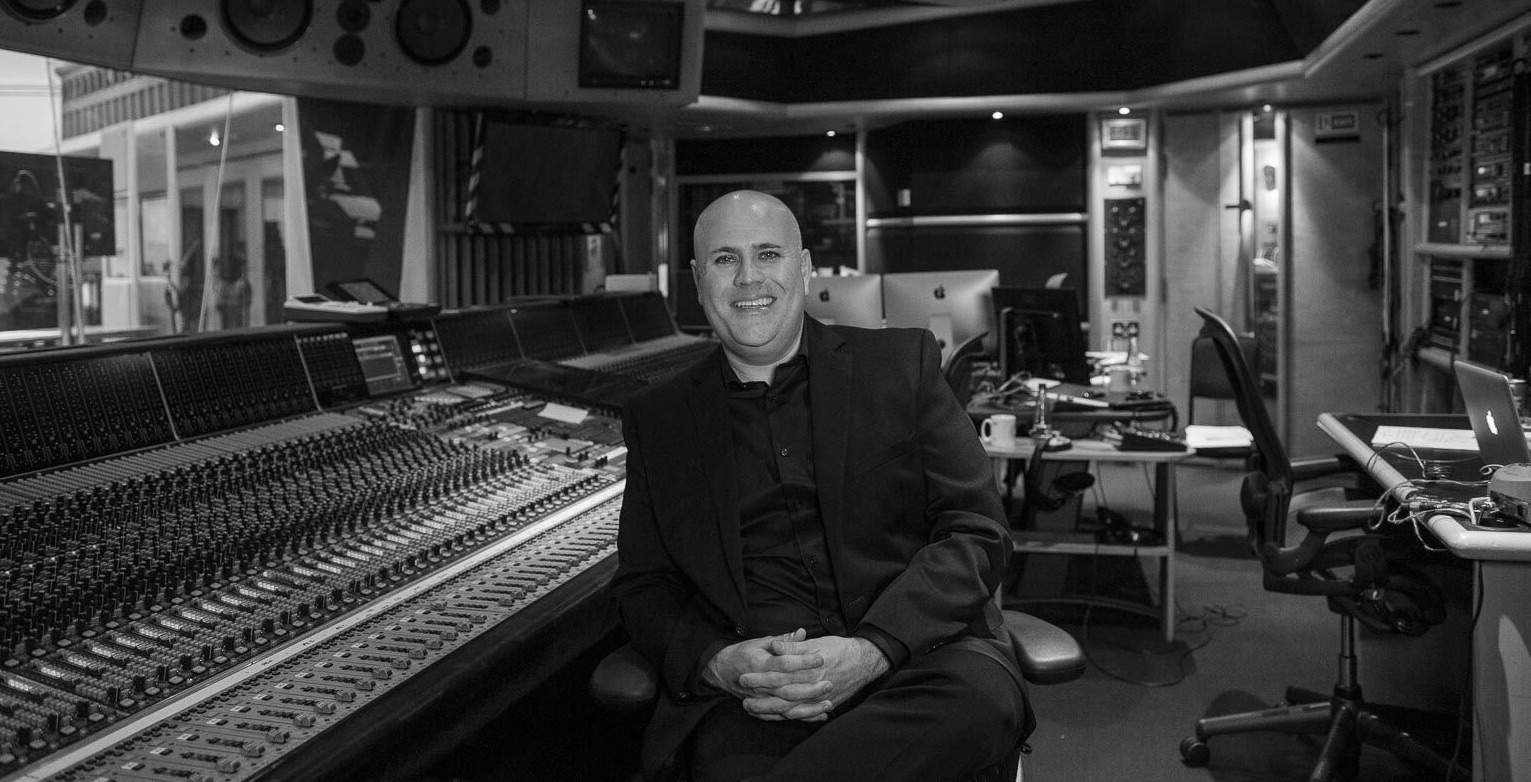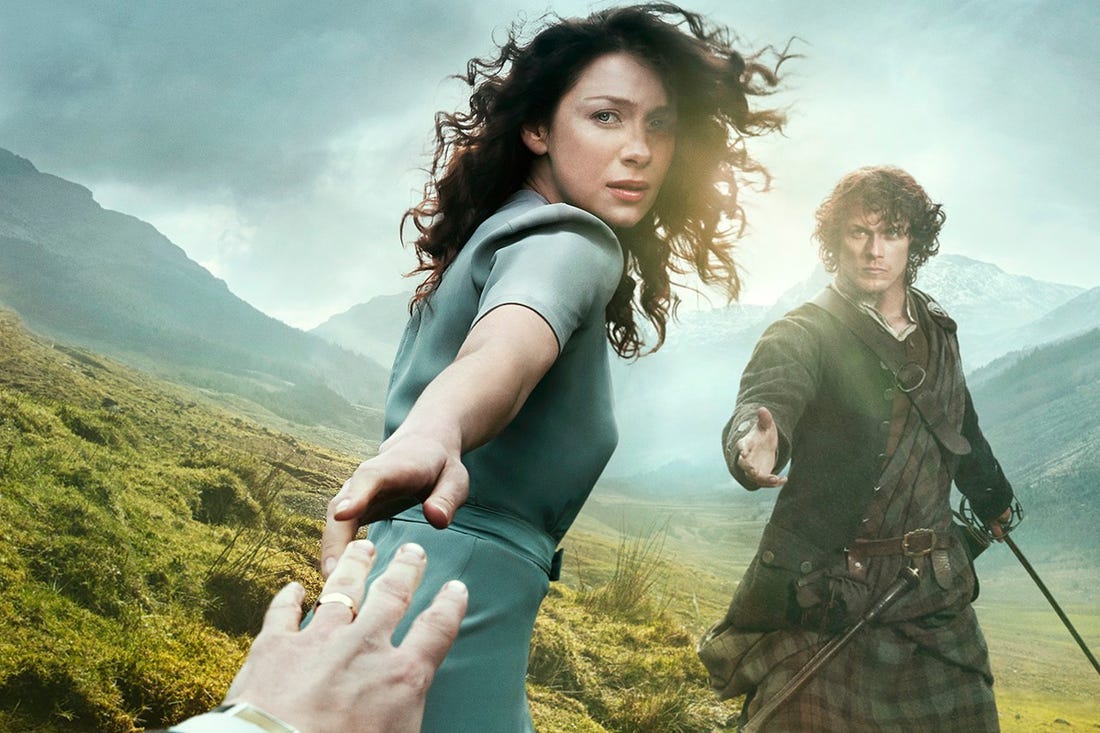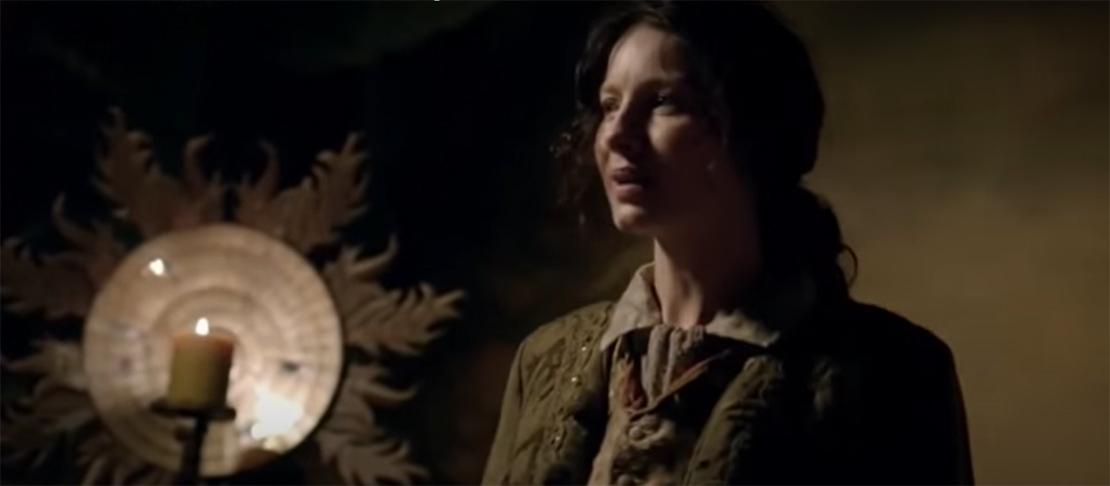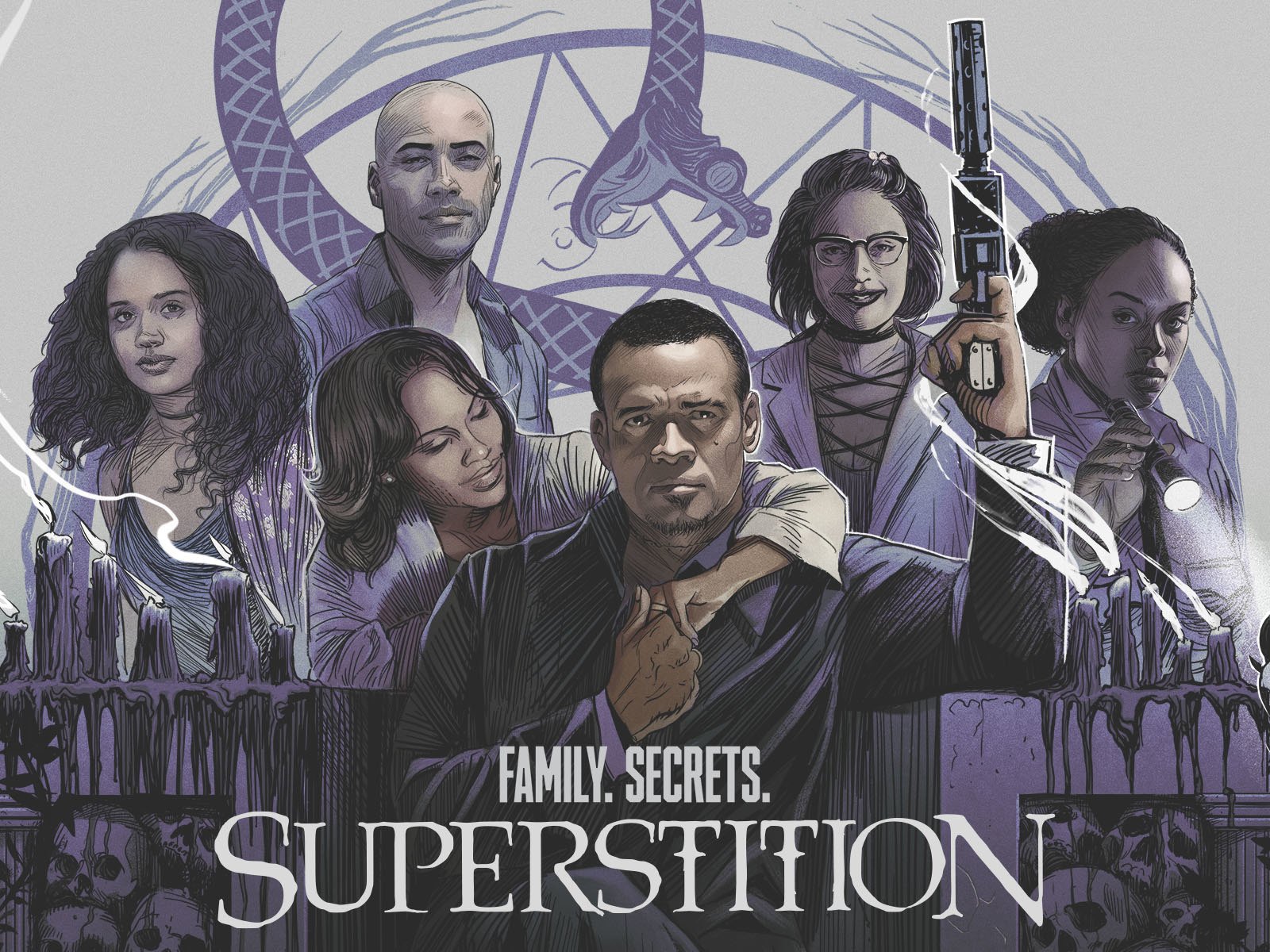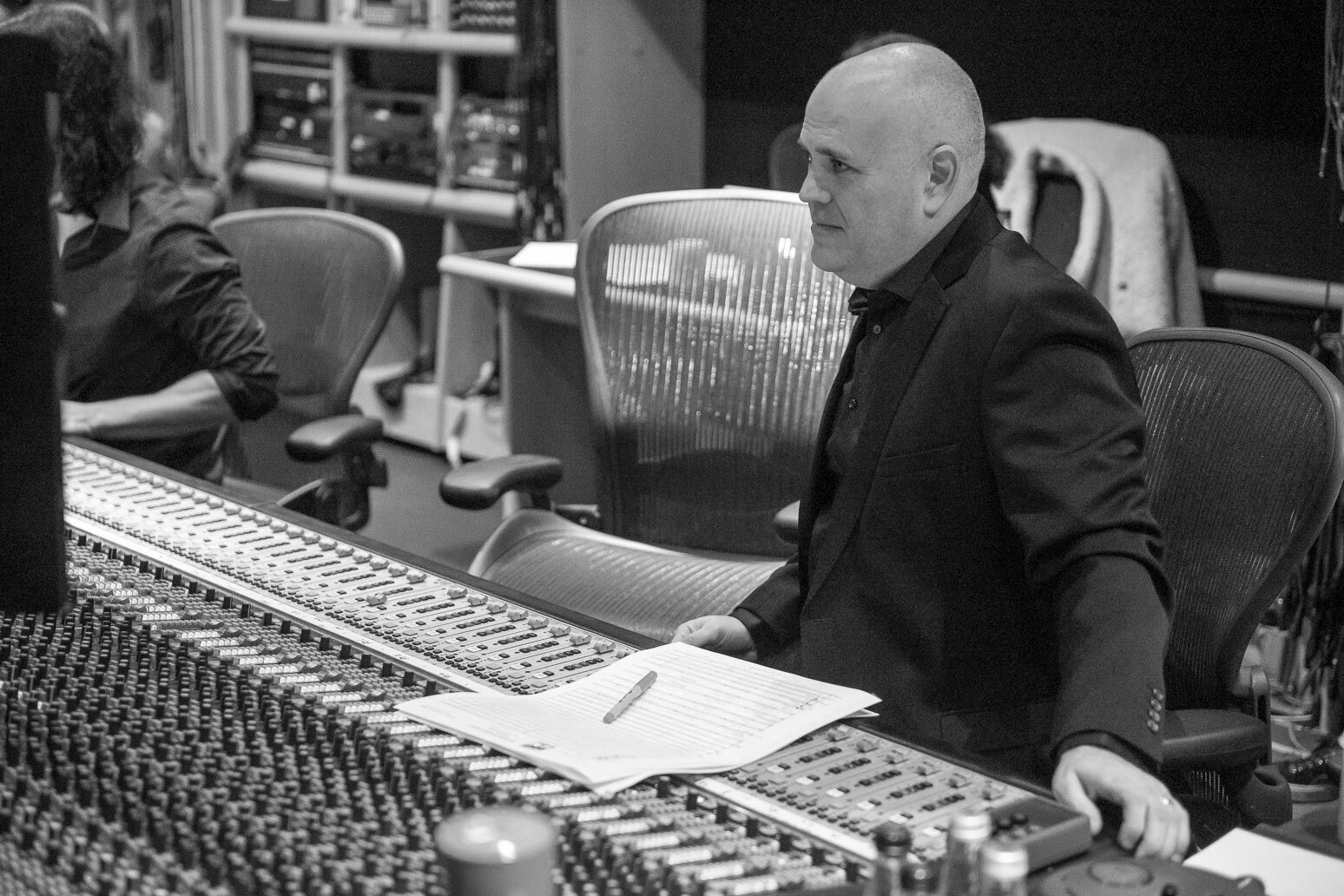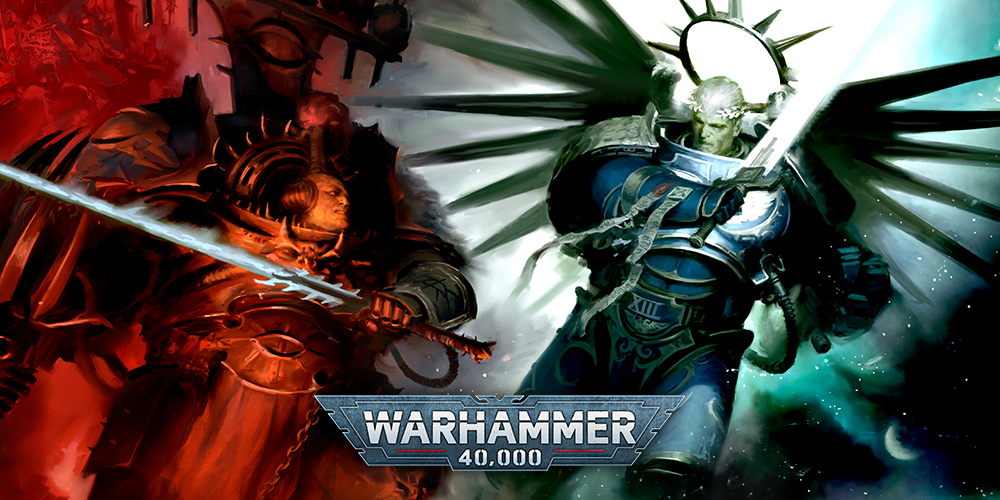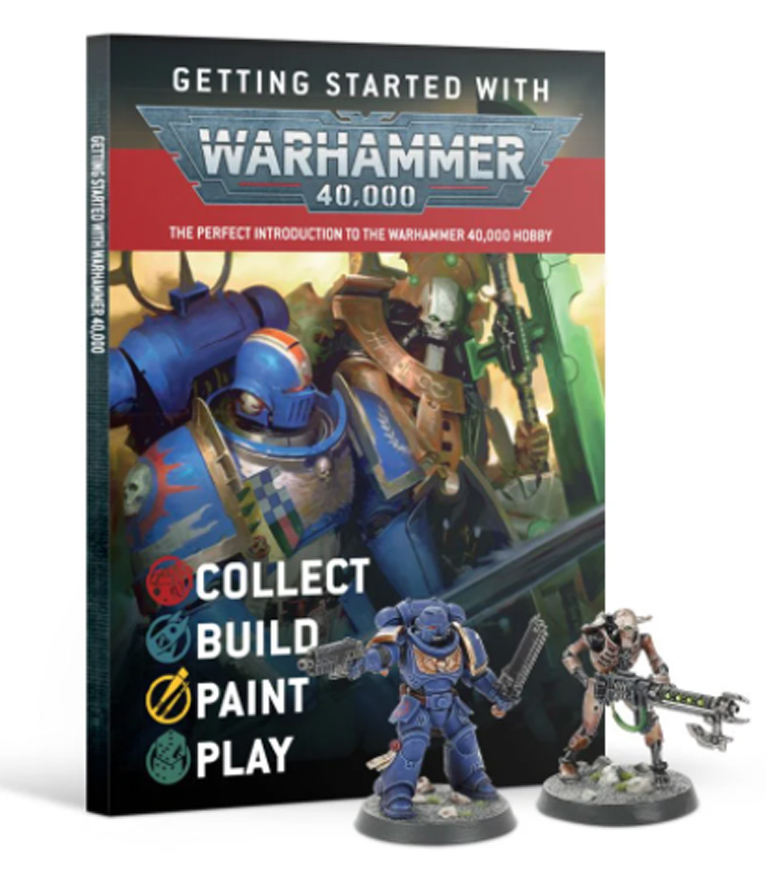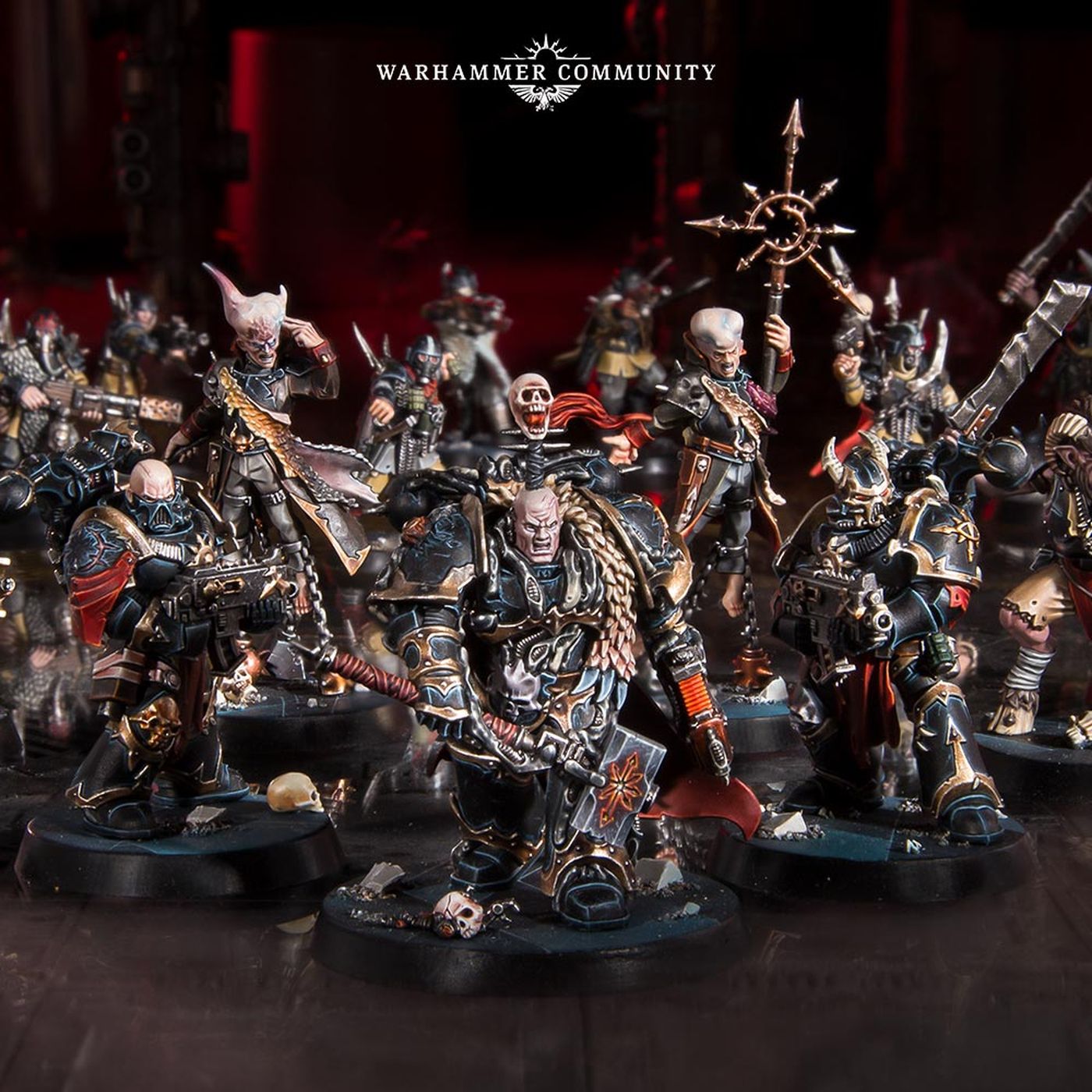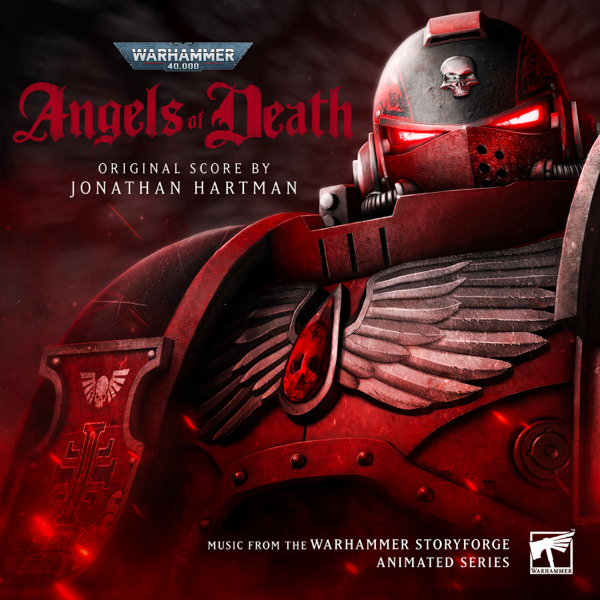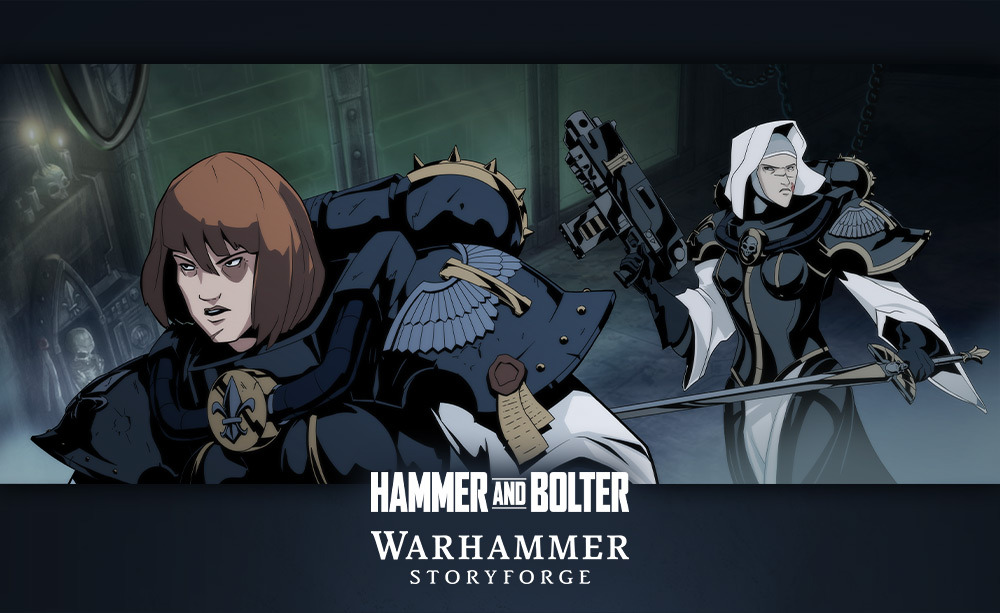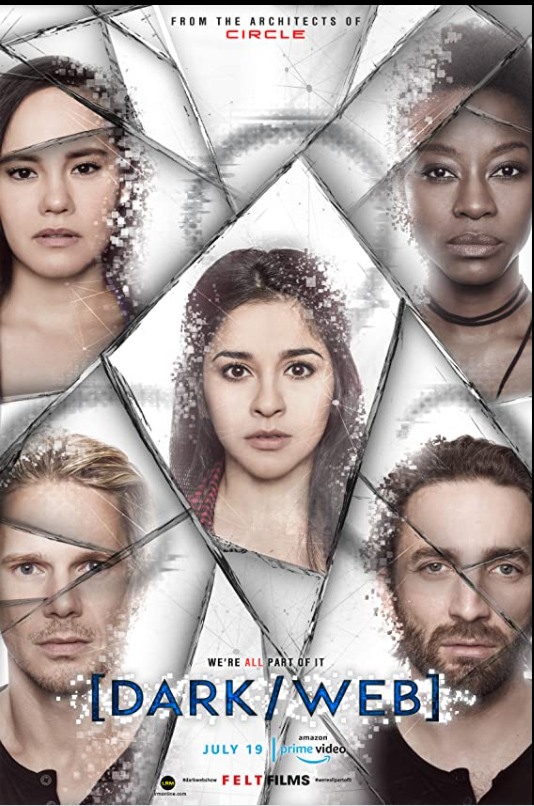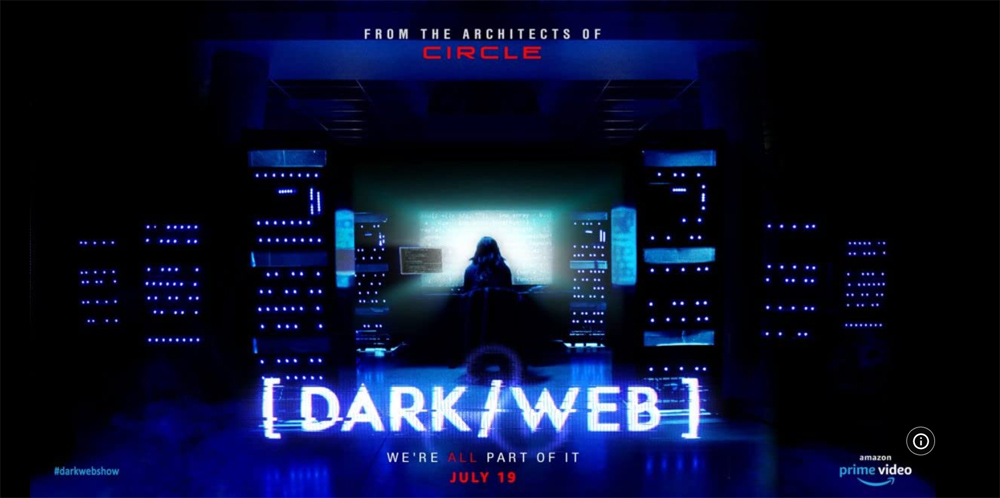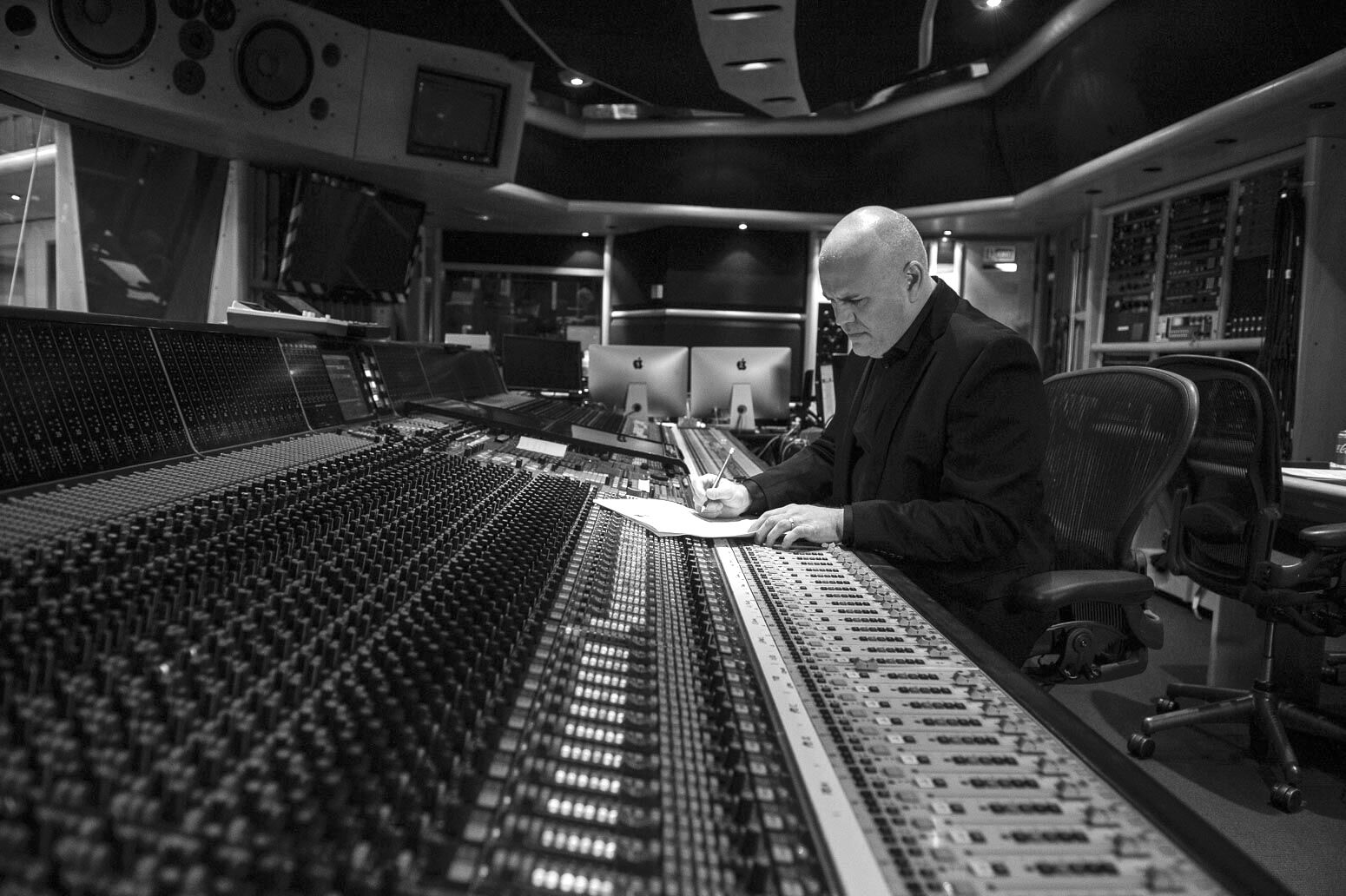November 18, 2019
Jonathan Hartman Faces WARHAMMER: ANGELS OF DEATH
Interview by Randall D. Larson
ANGELS OF DEATH is an animated series from Games Workshop set in their massively successful WARHAMMER 40,000 science fiction universe that features an especially provocative music score, which is vital in setting the tone for the series. The score is composed by Emmy-nominated composer and long-time Warhammer fan Jonathan Hartman, whose work is already a major part of the Warhammer ident. Hartman’s score is redolent of the grim, dark, powerful atmosphere of WARHAMMER 40,000 and stunningly evokes this slice of the 41st Millennium envisaged by the Storyforge team in audible form. The soundtrack album is a 39-minute feast of orchestral music, and is can be downloaded from the Black Library Audio app https://www.blacklibrary.com/My-Account/bl-audio-2020.html or on Apple Music https://music.apple.com/us/album/warhammer-40-000-angels-of-death-original-score/1518604326.
Hartman’s first feature film was THE EMPLOYER starring Malcolm McDowell, Paige Howard, and David Dastmalchian. Other films include FATAL HONEYMOON starring Harvey Keitel, and THIS LAST LONELY PLACE, a neo-noir thriller produced by the Humphrey Bogart Estate. Jonathan recently composed all of the authentic period music for THE CHAPERONE (PBS Masterpiece) starring/produced by Elizabeth McGovern and Julian Fellowes. Hartman broke into television contributing additional music on the first season of the hit series OUTLANDER (Starz) with Bear McCreary, and next scored SUPERSTITION, a SYFY supernatural series starring Mario Van Peebles. Jonathan is currently scoring more media for Games Workshop, including their Film/TV Production logo, and other upcoming projects.
Q: You broke into TV scoring by doing additional music for OUTLANDER with Bear McCreary. How did you break into that and how did that prepare you for what you’re doing now?
Jonathan Hartman: That happened many years ago. I used to work with Beth Krakower, who was a publicist who worked with Bear for forever, and she suggested I have lunch with Bear. At the time Bear was doing a number of shows at the same time and it was getting intense, and his daughter, Sonatine, had just been born, so he really needed help with everything. After he listened to a lot of the music I’d written at the time, he said “I think you’d be a really great fit for OUTLANDER.” I asked what that was, and he said, “It hasn’t come out yet, but it’s based on a very popular series of books. Why don’t you come in and do some additional writing on it?” I said “Great!” He’d written the first eight episodes already, so I had a good sense of all the themes and the sound of the show.
I have a very extensive jazz background, and he said “Oh, then you’re familiar with The Andrews Sisters?” I said, “Of course.” And he said, “We have this thing coming out and I think you could do it, where we have to do some music that’s going to be for live playback on set. This episode is about the main character who’s traveling through the countryside in 18th Century Scotland, and she ends up singing a variance of ‘Boogie Woogie Bugle Boy,’ but with instruments from that time period and a slightly variant Scottish lyric.” So he asked me to write an arrangement of that song with instruments from the mid-1800s. And I remember going, “Uhhh…. Yeah! Let me wrap my head around that for an hour or two, but, sure!”
And that was the beginning of that and, to be honest, it was an amazing experience. I had worked for John Ottman for several years just as a technical assistant, helping him in his studio, so I’d been around feature film scoring, and my mentor who got me into this business was Ira Newborn, he’d done all the John Hughes films and the Zucker Brothers who’d done things like NAKED GUN. But this was the first time being around a fully dedicated television guy. Obviously, now Bear does the features, too. But that was a tremendous learning experience, just to see how you juggle those shows, how you manage that schedule, and, especially, how you turn that schedule around when you’re doing so much live recording, and especially live recording of multiple shows? It was just incredible to be adjacent to that for some time, to be in it but not of it, because I wasn’t working for him as an assistant but it wasn’t like I’d just left college, either. I was an external guy writing additional music here and there.
Q: I believe it was after that you got involved with SUPERSTITION, the TV series. Tell me about coming into that show and scoring it, essentially, on your own?
Jonathan Hartman: That actually started nine to ten months before I was actually doing the show. The showrunner on that, Joel Thompson, had worked on a lot of great science fiction titles—he had been a writer for a few seasons on BATTLESTAR GALACTICA, he’d been a writer on FALLING SKIES, and after our show he went on to do a season of KRYPTON, just a brilliant dude. The way the show was pitched to me was about a man who is essentially immortal who purposely stays engaged with the world, he’s been married many times and raised different families, and sometimes they’ve all been part of the “family business” fighting evil, and he does so knowing he’s going to have to lose all of them. That struck me as a really powerful idea. This was about seven months before the show aired, and I just started writing concept pieces, based on my conversations with Joel and a couple of scripts he’d written. I wrote a lot of different pieces, and by the time I’d been hired to score the show I had maybe 30-35 minutes of conceptual music. The rational behind that was that we wanted to go into the show with a body of work that they could edit and temp to, and really have a sense of what the show would sound like before we did it.
The show wasn’t a procedural, but they had a lot of mystery-solving music every week, like “here’s the mystery-of-the-week that needs to be addressed.” So I wrote problem-solving music, that would work for different scenes, and that was punctuated by a fair amount of action material, where we had a ghost-of-the-week show—there was always some sort of confrontation with the supernatural—and then, because SUPERSTITION was also a family drama show in a supernatural package, there were a lot of dramatic moments and a lot of emotional revelations with the different characters interacting with each other.
Q: Did that show’s budget permit an orchestra, or were you restricted to digital music?
Jonathan Hartman: It was all digital; however with every episode we ended up having something live—whether it was a live percussionist or a live guitarist or a special lead singer coming in. There was one episode in particular, where I got a call from Joel saying “Hey, we’re going to need a really authentic Argentine tango!” “Sure! Uh, let me sort that out!” Luckily at the time, my assistant was from Buenos Aires, and he knew all of the Argentinian ex-pat musicians in L.A. so on that episode we had an amazing bandoneon player and a percussionist come in. That worked out and they were thrilled. In a sense it was like going back to the thing with Bear—one of the things that makes him an interesting composer is that even if the budget doesn’t allow a massive orchestra, he always tries to find one or two key elements that are real, that you can latch onto that are emotional, and that gets you half way there, especially in TV when the schedule’s so fast.
Q: Now you’ve done ANGELS OF DEATH, which is an animated offshoot of WARHAMMER. How does that all fit in together, both game-wise and music-wise?
Jonathan Hartman: WARHAMMER has had a number of videogames that were offshoot licensees from the main brand. What WARHAMMER actually is, in its essence, is a table-top miniatures wargame. In other words, you buy model kits like toy soldiers, or robots, or aircraft, or tanks and things like that. You build and paint a collection of them and then you can play games using a rule set against anybody else in the world who has also built and painted these models. It’s been around in different iterations for almost forty years now. Its earliest incarnations happened in the very late ‘70s/early ‘80s, and the way it came about is the two gentlemen who originally founded Games Workshop, the company that makes WARHAMMER, were the guys who had gotten the sole licenses to bring DUNGEONS & DRAGONS to the United Kingdom. Over time, there was a growing demand in the UK for people who wanted miniatures to represent their characters when they’re playing games like D&D, so these guys founded a miniatures sculpting company called Citadel Miniatures. That company then started getting bigger and eventually at a certain point they stopped doing D&D and they realized they had thousands and thousands of miniatures, and they thought, what if we created a rule set where people could play games with these miniatures we’ve been making? Over four decades they went from being literally a two-man operation and were living out of a van, to, at this point right now, I think they’re a two-billion point marketed value company in the UK. They employ thousands and thousands of people as sculptors and designers and painters and also people who write books and lore and background stuff, and then in addition to selling their brands around the world through independent stores, they have over 500 direct retail stores around the world where they sell their own games.
And so I’m actually scoring both series right now, as we speak. It’s a really exciting time—they expect probably by the end of the year a lot of this will finally be released for the fans, but initially they got to a place where the fan base is so rabid and so loyal—and I’m one of them, by the way, I grew up on WARHAMMER and I love the brand—where they decided to take the music that we’d done for ANGELS OF DEATH and as a prelude, put it out first, and I think everyone was pretty amazed at how well the fans received it.
And because it’s become so popular world-wide over the last ten years they’ve had a number of video games that have been licensed by third parties. They got to a place where they realized they were the largest untapped science fiction/fantasy intellectual property in the world that didn’t have a movie or a TV show! So they founded a media division called Warhammer Storyforge with the goal of taking all these hundreds and hundreds of characters and worlds that they’ve done over the last four decades and finding media opportunities for them. Some of the things they’ve publicly announced includes a massive TV series in development with Frank Spotnitz, and as a kind of prelude to those things they’ve decided they wanted to start engaging their fans quicker and one of the ways to do that was to doing some animation projects. There are currently two official animation projects that the world has been shown, one is ANGELS OF DEATH, which is near completion—it’s still working through the last of it—and the second one is another series called HAMMER AND BOLTER, which is like an anthology series where every episode goes into a different corner of their world and tells a story, shedding light on something the fans may not have seen before.
Q: You’ve also composed something for what’s called WARHAMMER IDENT—I assume that’s like a logo music or something?
Jonathan Hartman: It’s their global production logo. You know how at the beginning of Marvel movies you have the Marvel 30-second thing? They had M2 Animation in the UK create this, and so I scored their global production logo, and it’s also being used in front of all of their media efforts. We did that in December in London with a 90-piece orchestra and choir at Air Studios. I didn’t know it at the time, but I wanted it to be quite large, and we found out later it apparently ended up being the largest percussion recording session in all of 2019 in London! At the time we had 16 percussionists on that session playing 20 drums.
Q: When you started on ANGELS OR DEATH how did you come up with the kind of music you needed, the palette you had, and this tremendous about of truly epical music?
Jonathan Hartman: The epic part is the starting point. The thing about the current WARHAMMER 40,000 Universe is that it’s just insanely massive. It’s involved a lot of stories and galaxy-spanning concepts with millions upon millions of people converging on planets and fighting, and you have this kind of massive galactic empire with humans who are endlessly besieged by aliens everywhere in the universe. The WARHAMMER Universe is a very different universe than a lot of other science fiction brands in that it’s incredibly dystopic. There’s the sense that everything’s going to be lost at any moment with that universe; humanity is essentially barely holding on, and everything might be lost very soon as they get besieged by all these elements. And so a lot of early conversations with the men and women who had created this work has always been that it needs to feel incredibly large; it needs to feel over the top, and can we push that another ten percent? Just like on the Ident, “Hey! We have 22 massive drums! Awesome!” This is the kind of sensibility that’s in there.
And so from the very beginning it was always really clear that music for the WARHAMMER Universe needed to have two basic elements: (1): epic orchestral action sensibilities, and (2): a very off-kilter analog synthesizer element to it. The idea was that, in the far, far future, things like cheap analog synthesizers would be common, ubiquitous things that would be mass-produced in this kind of world, whereas something like a violin would be incredibly precious and rare, something very unique and not disposable. So the music would capture some of that weird, off-kilter detuned synthesizer sensibility.
“There had to be a lot of propulsive music that would just pull you through these episodes and move you through those sequences. It had to have endless forward momentum.”
Q: How would you describe the thematic construction of the score?
Jonathan Hartman: I’d say that the score divides up into three sections in terms of thematic use. The first batches are pieces of music that were specifically written for different characters. There are a couple of different named characters and heroes in the series, and we needed to have music that would function for them. In WARHAMMER 40,000—for the people who maybe are new to it—the thing people almost always identify with is this group of super-armed soldiers called Space Marines. They are, in many ways, the poster boys of Games Workshop’s brand. They have a giant statue of a Space Marine out front of their manufacturing facility in Nottingham, England, and they joke about it: “This guy’s paid for everyone’s college! He’s put food on the table!” So, being their first effort at doing these kind of projects, they wanted to make sure there were Space Marines, because that’s their brand. Space Marines tend to be shown as these incredibly dangerous and lethal killing machines, but underneath that they have strict rules imposed upon themselves on how they act in honorable ways with one another and with their enemies, and so forth. So I needed to create music that could be associated with three of those main characters. They have slight differences of opinion amongst themselves about which way they go. So that was a starting point of that first third of the music.
The second element of the music was that, it’s a show that in many ways is like a running-gun battle. It might remind you of the movie BLACKHAWK DOWN, where from the very beginning these marines are put into a dangerous situation that has a lot of enemies chasing them at all times and getting into conflicts with them. So there had to be a lot of propulsive music that would just pull you through these episodes and move you through those sequences. It had to have endless forward momentum. If we briefly have a moment to pause and breathe, we’d never have it for too long, and then we’re back to running and fighting. They’re essentially trying to get off world and get back to their ship and escape. So it always needed to have a sense where the timing is really imminent. Time is not on their side nor in their favor.
Then the third element are the atmospheric pieces in this score. That partly has to do with the enemies they’re facing in this show—the gene stealers are an alien race, they’re very sneaky, they’re in hiding and they pick and choose the moments when they’re going to ambush somebody, and it needed to have a sense of dread at all times. Another aspect is that the setting of the show involved a lot of these massive, what they call hive cities—imagine if Los Angeles was as tall as it was wide, just thousands and thousands and thousands of floors, vertical. There’s a visual vibe about that that has a very oppressive sense to it when you see these massive, massive cities, and they wanted to make sure we had a fair amount of material to evoke that sensibility. There would be establishing shots, and I’d need to serve that sense of place, and make it feel that it was truly lingering and huge.
Q: What can you tell us about the other project, HAMMER & BOLTER?
Jonathan Hartman: This other animation project is really interesting, because every episode is so different from the other as they start to explore different corners of the IP. I recorded some Celtic vocalists for an episode about these two warrior women who are called Sisters of Battle, and I wrote it like a fugue, and whenever they’re on screen there are vocals that represent each of them, and each one’s music intertwines and moves around the other. We’re going to be playing not only with that musically, but in the mix as well, depending on where they are visually on the screen, which will be interesting. There’s a fascinating episode coming up where we’re going to explore some of the alien groups in the world, and it’s a very exciting thing for them because they’ve spent thirty/forty years thinking of what these things look like, but no one’s ever stopped to ask, “Well, what do they sound like?” So there have been a lot of conversations with the people inside the design studio who wrote the lore and the backgrounds, as well as talking with some of the sculptors who have designed the characters, and just talking about “what went into why those characters look that way?” “Well, they have these influences, and maybe culturally they have this kind of sound…” So that’s exciting because it’s going to be one of the first times that we ever get to hear some of this music for these aliens, and some in a foreign language that has yet to fully be developed. Some of these characters and factions and worlds get so wonderfully weird and bizarre, and I think there can be unique opportunities to try and figure out for the first time what they are in terms of the sound.
Q: Now ANGELS OF DEATH has a soundtrack out there, as you mentioned… what about HAMMER & BOLTER?
Jonathan Hartman: Yes, without question. Another thing about that show that’s really interesting, is that HAMMER & BOLTER is being done by a different set of creators, by an animation studio out of Bristol, England called Sun & Moon, and they’re really sharp. They’ve done a bunch of interesting for the BBC, including some of the animated versions of DOCTOR WHO episodes that were lost or destroyed back in the late 60s and 70s. They have the original audio, which had been stored elsewhere, so BBC commissioned Sun & Moon recreate those lost classic episodes in animated form.
Q: I wanted to look back to a show that you were Emmy-nominated for, and that of course was the DARK/WEB TV series. What can you tell me about how you got involved and the kind of music that series needed?
Jonathan Hartman: It’s funny, that show is billed in some places online as a horror show but I don’t think I would describe it that way and I don’t think the producers, Michael Nardelli and Mario Miscione, would either. To us it’s always been more of a cyberthriller. It’s very much at its heart a mystery show where these friends are reunited almost like a millennial BIG CHILL, where they haven’t seen each other in forever and then they get together, partly because a friend of theirs has gone missing. The thrust of the series is them trying to solve the mystery of where the friend has disappeared to, and over the season we learn that she was involved in this company that was developing an artificial intelligence, and there’s something malevolent that’s related to the mystery and why she’s gone. Packaged inside of every one of those episodes—which has a full-on narrative storyline—are these anthology segments, so every episode has this small five-to-ten minute story segment inside the greater story, which tells a different story of the Dark Web, and all of them, then, at the end of their stories, have some sort of a tie-in back to the main story. The way that came about for my involvement, I was hired by Boman Modine, Matthew Modine’s son, and he was directing one of these anthology segments, called “Rideshare,” which I scored. It was about a guy who was a driver for an Uber or Lyft style app, and that app starts to blackmail him in a really disturbing way, forcing him to do these horrible things to make the world a better place. It has a kind of TWILIGHT ZONE vibe to it. So I scored that and Michael and Mario loved the vibe of it and invited me to do the whole series. I’d always loved creepy, conspiracy-vibe movies, things like THE PARALLAX VIEW or THE MANCHURIAN CANDIDATE, and this had some of that kind of unnerving, unsettling feel to it, but at the same time it was never bloody or gory.
The sound of the show, which we quickly figured out, needed both a very John Carpenter vibe and a very Tangerine Dream influence to it, and I think part of that, going back to that paranoid sense that the world isn’t what you think it is, has a THEY LIVE feel to it. That started an early conversation about: “What if this had a very strong, synthetic, synthesizer feel to it?” That was actually my first foray going into analog synthesizers as part of my workflow, and that was the first time I started looking for classic gear and trying to find different pieces of equipment to work with. In many ways that show was really important for me, because it was like a turning point in my writing sensibility where now that’s very much a standard kind of day-in and day-out thing for me, this kind of hybrid sound. But that was my first opportunity, that show pushing me that way, and I’m grateful to those guys for that opportunity. They built that show and did it without having distribution at first and they decided they were going to go for it and make something without having an outlet, initially, and they did well and eventually got it to Amazon and then it turned around. For a first-time show from first-time people going into television, that show accrued seven Emmy nominations and it won an Emmy for lighting, which doesn’t usually happen the first time out the gate! They had Emmy nominations for outstanding digital drama series, for directing, for title sequence, two nominations for guest performers in the series, one for music direction and for my score, another one for screenwriting … I’m immensely proud to have been a part of that.
Thanks to Ray Costa and Lana Lay of Costa Communications for facilitating this interview, and especially to Score Marine Jonathan Hartman for his enthusiastic and illuminating answers to my questions. -rdl


